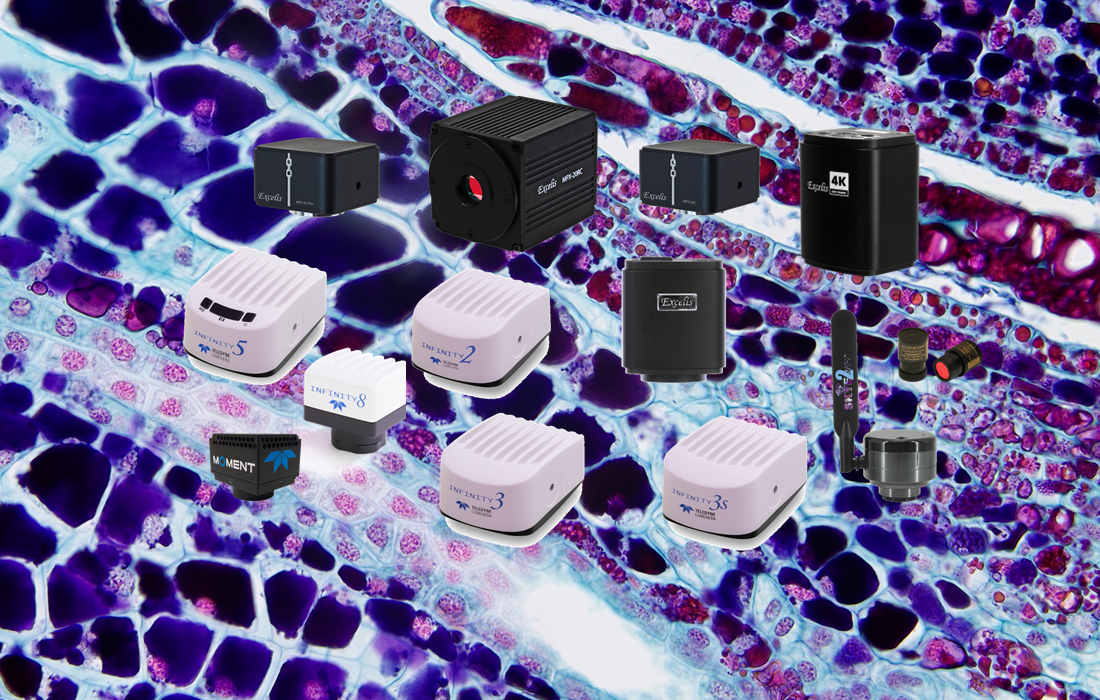Today’s microscopy cameras offer a wide variety of options for connecting to the camera and transferring data including camera control, image viewing and acquisition. Traditionally, cameras would feature one option for data transfer (e.g., USB port), but there is greater demand for flexibility in the way we connect to and control our cameras.
USB remains the standard for connectivity. Using software on a PC (Windows and sometimes Mac), the camera settings can be managed to view and acquire images, and typically offers very good flexibility for image processing, measurement and analysis. USB may also offer the convenience of providing power to the camera through the USB cable, thereby eliminating a separate power cord and adapter, while reducing clutter on the lab bench. Sometimes, however, data transfer via USB can be slower than other options we discuss below – the exception is today’s USB 3.0 connections with direct data transfer to the PC’s motherboard. To get the best and fastest performance from your USB camera when using a desktop PC, be sure to use a USB port on the back of the computer and not the ports in the front.
HDMI is a popular option for transferring a live stream of the image directly to a monitor (or TV) without the need for a PC. Frame rates are typically 30-60fps, and some newer cameras produce 4K images. Cameras require some form of control, and this comes in the form of built-in software (discussed in greater detail in our next episode). Some of these cameras will also have SD card slots or USB ports for storage of captured images onto SD cards or USB flash drives, respectively. WiFi connectivity is increasingly popular as it allows students and scientists to connect to and control the camera with their ever-present mobile phones – simply download the app to the mobile device, connect to the camera, and you are ready to start imaging. The mobile apps are relatively easy to use and navigate. These apps offer a streamlined selection of features compared to the computer apps, yet are quite sufficient for basic camera control and image acquisition. The one hiccup with WiFi cameras is that speed of live image viewing can be impacted by the resolution of the camera (more megapixels require more bandwidth to push the data over the WiFi), and this is compounded by the number of mobile devices simultaneously connected to that camera (the more devices connected, the slower the performance).

Ethernet and Gigabit Ethernet (GigE) ports are finding their way into some microscopy cameras. Where Ethernet runs at up to 100Mbps, GigE transfers data 10X faster (1Gbps). The most common application here is to connect the camera to a local area network (LAN), thus allowing multiple remote PCs to access and control the camera provided they are all connected to the same LAN and are running the camera’s imaging software. Another advantage is that the massive bandwidth allows multiple cameras to connect to a centralized imaging computer. Depending on the imaging software, you could consider running multiple imaging experiments at the same time.
Multiple Connectivity
Today we are finding more cameras offering combinations of connectivity forms. A camera with HDMI is commonly available with a USB connection.
- Teledyne Lumenera Infinity 5 cameras feature HDMI and USB
- Watch live HD video on a monitor via HDMI.
- To ensure accurate color in the image, a white balance button is located on the camera housing.
- Snap an image to on-board storage.
- Connect to PC via USB and get all the benefits of camera control, image processing and analysis with INFINITY Analyze software (available at no cost).
- ACCU-SCOPE Excelis HD camera has HDMI, USB and removable storage.
- The Excelis HD will stream live HD video to a monitor, and also includes built-in software for better camera control and some basic measurement capabilities. ACCU-SCOPE also offers a model with an attachable HD monitor for the ultimate in a stand-alone imaging system.
- Connect the Excelis HD to a PC and control it using CaptaVision+ software.
- Snap an image (or video) and save it directly to the removable SD card. A convenient option to transfer those images to a PC at a later time.
- ACCU-SCOPE Excelis 4K features both USB and HDMI connections and adds a GigE Ethernet port.
- Live stream directly to a monitor via HDMI without a computer. Use a 4K monitor for the best viewing.
- Use the GigE port to connect to a local network. Any computer on the same network and with CaptaVision+ installed can view live images and even control the camera.
- The USB 3.0 port connects to your Windows or Mac PC for camera control and advanced imaging capabilities using CaptaVision+.
- The ACCU-SCOPE SKYE WiFi 2 camera provides both WiFi and USB connection options.
- The 2.4GHz and 5GHz WiFi bands are ideal for connecting to an Apple iOS or Android mobile device with the SKYE View 2 mobile app.
- PC users can connect to the SKYE WiFi 2 camera by WiFi or USB and control the camera with the SKYE View 2 for Windows app. Mac support is not yet available.
- SKYE WiFi 2 supports up to 13 connected devices without appreciable loss in frame rate.
The take-home message: Choose a camera that offers the best type of connection for your type of work. Students love to use their cell phones, so a WiFi camera may be attractive for classroom settings (NOTE: Due to traffic on WiFi bands, only a few WiFi cameras may be able to operate simultaneously in a classroom environment). A USB camera may be optimal for situations where you have a dedicated imaging station with a microscope and computer. A GigE connection may be ideal for high bandwidth and access to live images across a facility’s computer network. You have plenty of options!
Stop back later for our next issue where we’ll discuss controlling your camera.
